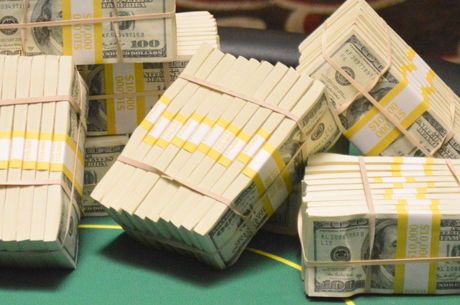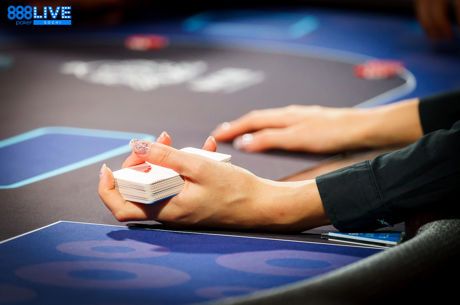Strategy Vault: Playing Third Street in Razz

Digging deep into the PokerNews strategy archives can lead to a buried treasure, so we'll be unearthing a few gems for your viewing pleasure. In this edition of the Strategy Vault series, we'll look back at the second part of a piece from Ashley Adams about the often forgot about game of razz.
In the first part of this series, I explained that the most thorough strategy on the game of razz presented in David Sklansky's book Sklansky on Poker. I also explained that most of the razz games that I've found, in rotation games like H.O.R.S.E. and online, with many poor players, can be beaten with a far simpler strategy. I promised to give you that strategy, and I'll start here with third street.
Lesson 1: Third Street
Rule 1 — Tight is generally right; fold with even one bad card.
For the most part, the simplest street to play, and the most important, is third street. You have three cards and need to make a basic decision about whether and how to play your hand.
In general, you want to fold on third street unless you have three cards of eight or less. There are exceptions to this — times you'll play with a nine or a ten or as a bluff even with paint, or when you're the bring-in, of course. There are also times when you'll fold your eight, or even your seven, but for the most part you want to play when you have three cards eight or less.
There are many players who don't follow this general rule. They'll frequently call a raise with two low cards and a brick — for example, (Jx6x) / Ax or (QxAx) / 2x. Some of them will even call with two low cards and a brick when their brick is exposed — for example, (6xAx) / Jx or (2xAx) / Qx. These same players will frequently raise from any position with just an exposed low card — even with one or two bricks in the hole. Their attitude appears to be that they only have to worry about what their board looks like, but they don't even worry about that some of the time.
At times, it is tempting to play along with these ultra-loose players, to copy their play. Hey, if they're raising with a low up card, two bricks, and pulling in some pots, maybe you should reraise with a hand you think might be slightly better, right? No, wrong. For example, they raise with a three, and you have a (9x6x) / 8x, so why not re-pop them? You may be thinking that they're probably semi-bluffing with some paint in the hole, and some writer somewhere wrote that the best defense against a semi-bluff is a raise, so why not raise?
Wrong!
In these games, you'll make your money from the terrible wild, loose, bad players who call and raise with garbage. But you won't make your money by playing a shade tighter. You'll make your money by rarely taking chances — knowing that you don't need to take many chances to get their money.
Let's say an opponent raises with an eight up, and you have (2x9x) / 8x, (2xJx) / 7x, or (Qx3x) / 6x. You may think to raise, but you should fold. True, you may be ahead of them, but why risk it when the antes are very small relative to the bet and there will be plenty of other opportunities with better starting hands to come?
Wait until you have three cards under an eight, a smooth eight, or a concealed eight. If you have three cards under an eight, go ahead and raise. Don't get cute and try to lure your opponents in, they'll probably call you anyway. Hell, they make that move when they have a brick in the hole, so they may well suspect you are just reraising to snow them. Meanwhile, you'll knock out all of the other players who might have called the single raise, and that's what you want, to go heads up with the poor, loose player even if he has paint in the hole.
Some players at this level, convinced by a few successful ventures that aggression is the key to winning at razz, will raise with their eight. If you reraise them with a seven, let's say, they figure that you're trying to snow them, and they often call. I've even been rereraised before. These players figure that they may win on the next card if you catch bad and they catch good. And you know what? They're right. They probably will win in those situations when you either pair your sevens or catch paint, and they catch a low card, but here's what they may not know or may not care about.
Your opponents drawing good against you when you draw bad will only happen, on average, about 25% of the time. The other 75% of the time, either you'll both catch bad, you'll both catch good, or you'll catch good and they'll catch bad. That's 3:1 against them in your favor, and I like those odds. Plus, the times they catch good and you catch bad and you fold when they bet, you'll be reinforcing their belief that their call of your raise or their rereraise was a good move, so have at it.
What you don't want is to just call their raise if you have a hand you know is better than theirs. Sure, deception has its place, and if you start to learn the styles of the players you're playing against and tag someone as a tight player, you can surely try a deceptive call on third street when you have the best hand, but in general, especially when you are getting started against relatively unknown opponents, you want to take the safer route. Raise the hands you have an obvious edge over, and don't encourage players to call and draw behind you who might otherwise have folded to your reraise. Make the initial raiser pay for his mistake, even if he or she may fold to your reraise. Tight and aggressive gets the money in these games.
Similarly, if you find yourself with a seven low or better on third street, you want to raise if the pot has not yet been raised. True, players after you with lower cards may hold a better three-card low, but you can't play razz always worried about that. A seven low or better is a very strong hand, especially with the seven unexposed. If you have it, you should generally raise to drive out those who would be happy playing a smooth eight or higher for a single bet.
There are exceptions to this, of course. If you are early in the action with a rough seven and many of the cards that will make your low are dead, then you should generally fold. Let's say, for example, that you see the following hands distributed around the table, with a king to your immediate right:
Seat 1: (XxXx) / Kx
Seat 2 (you): (5x6x) / 7x
Seat 3: (XxXx) / 4x
Seat 4: (XxXx) / 2x
Seat 5: (XxXx) / Ax
Seat 6: (XxXx) / 8x
Seat 7: (XxXx) / 3x
Seat 8: (XxXx) / Qx
In this case, you should fold your seven. Others may well be ahead, and they have the cards you need to catch to make a low — a 4x, 2x, Ax, and 3x are all out, with even an 8x also gone. You can wait for a better opportunity.
You don't have to play super tight, so don't get confused. If a lower up card than yours raises before the action gets to you, you can call with a smooth eight (and eight with two cards of five or less) provided the cards you need are relatively live. Especially if the low cards you hold are duplicated elsewhere.
For example, if you see the following:
Seat 1: (XxXx) / Kx
Seat 2: (XxXx) / 4x
Seat 3: (XxXx) / 4x
Seat 4: (XxXx) / Ax
Seat 5 (you): (4x8x) / Ax
Seat 6: (XxXx) / 7x
Seat 7: (XxXx) / Qx
Seat 8: (XxXx) / 10x
In this example, imagine one of the fours raises in front of you. You can go ahead and call with your eight. If your eight were exposed, or if the two fours were a five and a six, you could fold since some cards you need would be out and you'd have a weaker board. So much of razz is recognizing your position and your dead/live cards.
This article was originally published on November 4, 2006.
Want to learn more about the different variants of poker? Check out the Poker Rules section here on PokerNews.
To stay on top of the poker world, follow us on Twitter and like us on Facebook.









